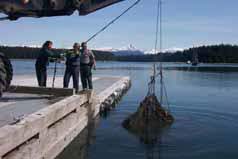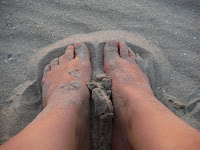Interview with Whale Biologist Christine Gabriele and the Whale with Three Names
The Whale with Three Names
Chris Gabriele, a whale biologist at Glacier Bay National Park (NP) in Alaska, never expected to be holding a rope attached to a 35 ton humpback whale. A call to park headquarters had come in at 3:00pm—a dead whale was floating in the bay. It didn’t take long to identify the whale as Snow, a female, biologists had tracked since 1975. The nickname Snow came from the spray of white dots on her flukes. Fluke markings are unique to each whale just as your fingerprints are unique to you . “Snow’s was one of the earliest recorded flukes in the Whale Tail Catalog,” says Chris, “her second official name was Whale #68.” |
| From the SE Alaska Fluke Catalog. Photo credit NPS |
No one at headquarters could believe Snow was dead. “Snow was a healthy adult,” says Chris. “We agreed a necropsy should be performed to determine the cause of her death.” Three boats dragged the 45.5ft whale ashore. Dr. Gulland, from the Marine Mammal Center in California, and a six-person team did the examination. Snow’s skull had been fractured by a collision with a cruise-ship. “Sadly,” says Chris, “we also learned that Snow had been pregnant.”
 |
| Snow's body was hauled up onto the beach for an necropsy. Photo Credit NPS |
Using Sound to See the World
“Because the ocean can be dark and murky, whales mainly rely on their ears to see,” says Chris. “Whales use sound to find food and avoid predators.” So why didn’t Snow get out of the way when she heard the ship? “Whales hear the engine at the rear of a ship,” says Chris, “but the front arrives 20-40 seconds sooner. My theory is by the time a whale notices the front of the ship, they don’t have time to avoid it. The best thing captains can do is go slow in known whale areas. Snow’s death has led to greater dialog with ship captains. We are teaching them about whales, and they are teaching us about ships.”Whale Earwax can be Read Like Tree Rings
“Even with sightings of Snow for 26 years,” says Chris, “we didn’t know exactly how old she was.” Snow’s earwax-plugs held the answer. Whales accumulate layers of earwax in their ear canals that look similar to tree growth-rings. But biologists didn’t know if humpback whales added one or two layers per year. “We counted 45 layers in Snow’s ear,” says Chris. “From our sightings, we knew Snow was at least 26 years old, so she must have added only one layer per year.” With this new information, researchers determined whales live at least 40-60 years!Counting earwax-layers, however, can only be done on dead whales. For population studies, biologists wanted a non-lethal way to tell a whale’s age. Snow’s earwax-age helped scientists discover that whale fat, or blubber, can be analyzed to determine their age. Taking a small sample of blubber from a live whale causes no harmful effects.
A Pile of Bones to a Complete Whale Skeleton
The NP decided to use this rare find of a humpback whale for an educational exhibit at the park. Chris was asked to spearhead the project. “Before Snow’s bones could be displayed,” says Chris, “thousands of pounds of flesh and fat had to be removed. But you can’t just pick up a 35 ton whale and carry it away.” They left Snow’s body on the beach to decompose.
 |
| Soaking Snow's Bones in the Ocean. Photo Credit NPS |
Fifteen months later, volunteers helped pull apart the bones. “It was a dirty job!” says Chris. “We bundled this huge pile of bones into fishnets and hung them in the ocean where sea creatures nibbled on them.” Whale bones are famous for being full of oil and Snow’s bones were no exception. Even after several months in the ocean the bones were still oily. Park staff, along with kids and adults from the community boiled and cleaned a total of 161 bones.
 |
| Snow's brain was about the size of two soccer balls. Photo credit Dan DenDanto |
“Dan DenDanto of Whales and Nails was hired to do the final cleaning and re-assembly of Snow’s skeleton,” says Chris. It took Dan over two years at his workshop in Maine to finish the articulation project. His team brought Snow back to her new permanent home at Glacier Bay Park headquarters.
 |
| The Whales and Nails Team |
Snow’s Third Name
On June 25, 2014—fourteen years after Snow’s death—the National Park celebrated the opening of the new whale skeleton exhibit. The Hoonah Tlingit people returned to their homeland for the event. They performed a spirit ceremony, and gave Snow her third name, Tsalxáan Tayée Yaay—Whale Beneath Mount Fairweather. |
| The Hoonah Tlingit had to leave the bay 300 years ago because of an advancing glacier. They revere Mount Fairweather, one of the snowiest places on Earth. Photo Credit NPS |
Snow’s is the second largest humpback whale skeleton on exhibit in the world. “The story of Snow’s life,” says Chris, “and the people who worked together to tell that story, is even bigger than the skeleton itself.”
 | |
| Snow's Tail Photo Credit NPS Photo credit Charles Jurasz |
Additional information about Snow can be found at: https://www.nps.gov/glba/learn/nature/whale-68-articulation-project.htm


Comments
Post a Comment